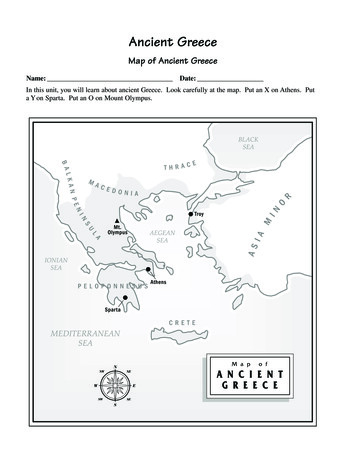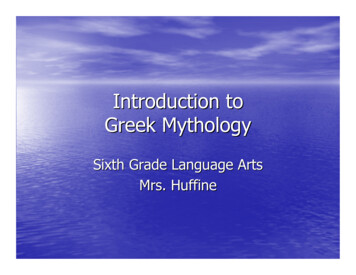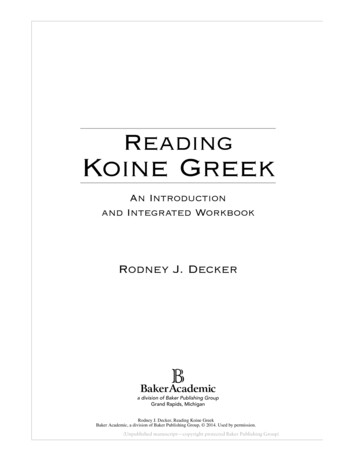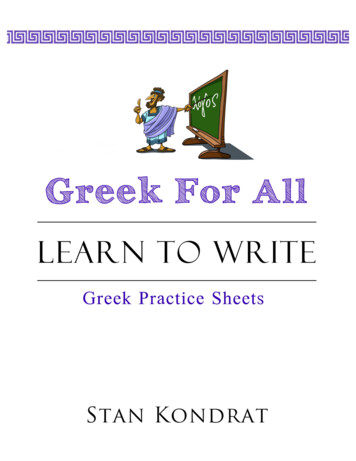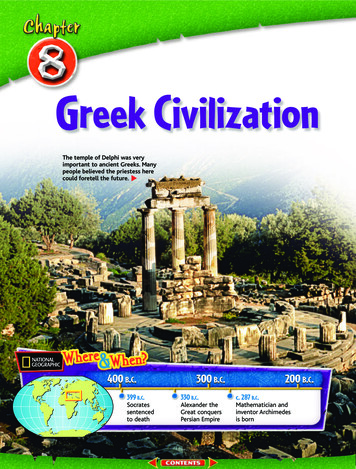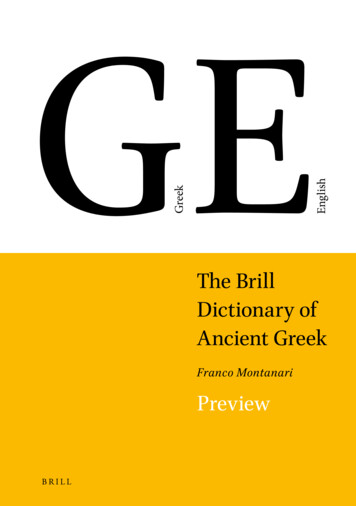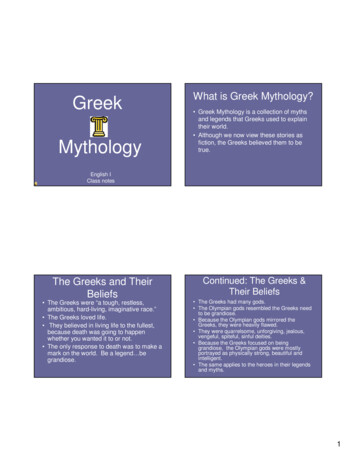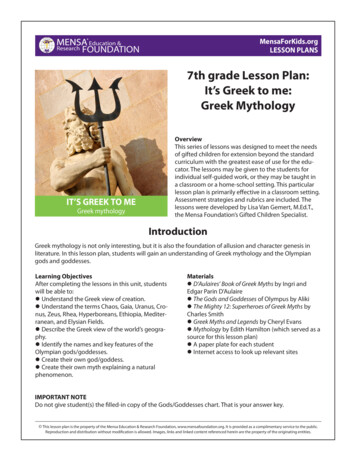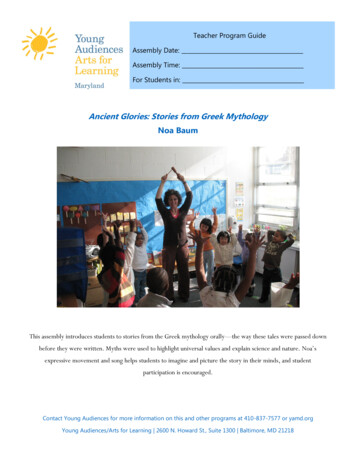
Transcription
Teacher Program GuideAssembly Date:Assembly Time:For Students in:Ancient Glories: Stories from Greek MythologyNoa BaumThis assembly introduces students to stories from the Greek mythology orally—the way these tales were passed downbefore they were written. Myths were used to highlight universal values and explain science and nature. Noa’sexpressive movement and song helps students to imagine and picture the story in their minds, and studentparticipation is encouraged.Contact Young Audiences for more information on this and other programs at 410-837-7577 or yamd.orgYoung Audiences/Arts for Learning 2600 N. Howard St., Suite 1300 Baltimore, MD 21218
Teacher Program GuideAssembly Date:Assembly Time:Please pass along the attached teacher program guide to all participatingclassrooms.Setup Requirements Microphone on stand Performance space with no doors (that areused during performance) behind Noa Students seated in semi-circles or theaterstyle Small table or stool with no back on stagefor Noa's waterArtist Arrival Time30 minutes prior to performanceSuggested Introduction“Ladies and Gentlemen, Boys and Girls, stories are about to be brought to life! Let’s give a warm welcome to Noa Baumas she presents Ancient Glories: Stories from Greek Mythology.”Inclement WeatherDON’T WORRY! Artists will follow school closings/delays, and will work with you to reschedule the performance ifnecessary.Young Audiences Contact Number410-837-7577After Hours / Emergency NumberCall 410-837-7577 and follow the prompts to be connected with a staff member on call.Contact Young Audiences for more information on this and other programs at 410-837-7577 or yamd.orgYoung Audiences/Arts for Learning 2600 N. Howard St., Suite 1300 Baltimore, MD 21218
Teacher Program GuideAssembly Date:Assembly Time:Artist BioInside this Guide: Artist BioProgramDescriptionMaryland StateCurriculumConnectorsCore CurriculumConnectorsVocabularyBackground InfoClassroomDiscussionQuestionsList of ResourcesPre- and PostPerformanceIsraeli-born Noa is an internationally acclaimed storyteller who uses mesmerizingvoices, impeccable timing, and warm authenticity to captivate audiences and confrontimportant topics, such as bullying and intolerance. Noa shares stories from diversecultures and her own rich Jewish heritage to highlight our similarities and celebrateour differences. Trained in theater and education at New York University, Noa is aParents’ Choice Award winner and recipient of numerous awards from the MarylandState Arts Council and the Montgomery County Arts Council.Noa holds a BFA in Theater from Tel Aviv University and was an actress with theKhan Repertory Theater of Jerusalem. She also studied with acclaimed acting teacherUta Hagen in NY, and holds a Master of Arts in Educational Theater from New YorkUniversity (NYU). Noa received a Graduate Fellowship to work in inner city schoolsfrom C.A.T., the Theater in Education Company of NYU.Noa has been living in the U.S. since 1990 and touring internationally. She haspresented at hundreds of venues including the World Bank, the Mayo Clinic, theKennedy Center, The US Defense Department, GWU Law School, Brandies andStanford Universities, and Hebrew University.Contact Young Audiences for more information on this and other programs at 410-837-7577 or yamd.orgYoung Audiences/Arts for Learning 2600 N. Howard St., Suite 1300 Baltimore, MD 21218
Teacher Program GuideAssembly Date:Assembly Time:Program DescriptionThis assembly introduces students to stories from the Greekmythology orally—the way these tales were passed downbefore they were written. Myths were used to highlightuniversal values and explain science and nature. Noa’sexpressive movement and song helps students to imagineand picture the story in their minds, and studentparticipation is encouraged.“Noa Baum was warm and engaging. She establishedimmediate rapport with the audience, giving clear cues fordecorum, but lots of space for appropriate response andparticipation. Her stories were mesmerizing, her timingimpeccable, and her connection with the children genuine.Loved her!”- Nan, Principal, AlephBet Jewish Day SchoolContact Young Audiences for more information on this and other programs at 410-837-7577 or yamd.orgYoung Audiences/Arts for Learning 2600 N. Howard St., Suite 1300 Baltimore, MD 21218
Teacher Program GuideAssembly Date:Assembly Time:Maryland State Curriculum ConnectorsStandard 1.0 Perceiving and Responding: Aesthetic EducationStudents will demonstrate the ability to perceive, interpret, perform, and respond to the development of a varietyof dramatic forms over time and the aesthetic qualities they reflect.Common Core Standard ConnectorsCCSS.ELA-Literacy.CCRA.SL.3 Evaluate a speaker’s point of view, reasoning, and use of evidence and rhetoric.CCSS.ELA-Literacy.CCRA.L.3 Apply knowledge of language to understand how language functions in differentcontexts, to make effective choices for meaning or style, and to comprehend more fully when reading or listening.Contact Young Audiences for more information on this and other programs at 410-837-7577 or yamd.orgYoung Audiences/Arts for Learning 2600 N. Howard St., Suite 1300 Baltimore, MD 21218
Teacher Program GuideAssembly Date:Assembly Time:Vocabulary Cyclops – a savage one-eyed giant Island of Ithaca – a Greek island in the Ionian Sea, the smallest of the Ionian Islands: regarded as the home ofHomer's Odysseus Bard – a poet Oral Language – encompasses all modes of expression of which only a small part is words Mythology – a body or collection of myths belonging to a people and addressing their origin, history, deities,ancestors, and heroes. Mount Olympus – a mountain peak in northeast Greece near the Aegean coast; believed by ancient Greeks to bethe dwelling place of the godsContact Young Audiences for more information on this and other programs at 410-837-7577 or yamd.orgYoung Audiences/Arts for Learning 2600 N. Howard St., Suite 1300 Baltimore, MD 21218
Teacher Program GuideAssembly Date:Assembly Time:Background InformationFor many thousands of years, long before there were written words – people told stories. Stories were part of the lifefabric of the whole community, not just for kids! What people heard they passed on. We call this way of passing onstories The Oral Tradition. There were also special people who worked especially hard to listen and remember andpass the stories on. They were the elders, the spiritual leaders, the bards, the poets, and the storytellers. What is Storytelling?At its core, storytelling is the art of using language, vocalization, and/or physical movement and gesture to revealthe elements and images of a story to a specific, live audience. A central, unique aspect of storytelling is itsreliance on the audience to develop specific visual imagery and detail to complete and co-create the story. Welisten, but actually, we see story. We see places and people in the movie of our mind. A good story stays with usin our hearts through the pictures we create with our imagination, in our mind.What is Oral Language? Storytelling distinguishes written language from spoken language – in the resonance of voice there is meaning andintent, how and when we pause, our attitude and emotional emphasis – our individual human presence. We useall these, in addition to words, to tell stories. Developmentally, our first language is the spoken or oral language: we learn to communicate our needs andinteract long before we can form words and speak. We learn to speak and express ourselves using the complexityand richness of oral language long before we learn how to read and write. Oral language encompasses all modes of expression of which only a small part is words. Tone of voice, rhythm and silence, gestures and body language, posture and use of space, facial expression, andeye behaviors are all part of our communication power and are stronger than the content or words we use.Classroom Discussion Questions What qualities do you think a good storyteller has? Why is storytelling a useful and important skill?Do you think it’s easier to re-tell true stories or to make them up from your imagination? Explain.Which Greek Mythological creature(s) do you like the best? Explain.Contact Young Audiences for more information on this and other programs at 410-837-7577 or yamd.orgYoung Audiences/Arts for Learning 2600 N. Howard St., Suite 1300 Baltimore, MD 21218
Teacher Program GuideAssembly Date:Assembly Time:List of Resources Learn more about Noa Baum – listen to her stories, email her questions, and discover additional storytellingprograms at http://www.noabaum.com/Aesop's Fables Online – Thousands of Aesop's Fables in five languages from the likes of Joseph Jacobs and WilliamCaton, among others. You won't have to cry wolf to find what you need! http://www.mythfolklore.net/aesopica/The Electronic Text Center – University of Virginia Library - Browse by culture: English, French, German,Spanish, Latin, Chinese, Japanese, Russian, Apache, Greek, Hebrew, Tibetan, Icelandic, Italian, and Portuguese. Youwill never run out of stories to read. "Holdings include approximately 51,000 on- and off-line humanities texts intwelve languages; with more than 350,000 related images (book illustrations, covers, manuscripts, newspaper pages,page images of Special Collections books, museum objects, etc.)": http://etext.lib.virginia.edu/Greek Spider: Sixteen stories from the ancient land of Gods and Goddesses –http://www.greekspiderl.com/greek folk tales/New Year Traditions Around the World – Do you ever wonder why a baby is the symbol of the New Year? Findout and make an easy connection to Greek Myths for your students: http://tinyurl.com/35ez8Myths and Legends of Ancient Greece and Rome, 1880 – This is a free download.http://tinyurl.com/k9ynxcvMythic Crossroads: Myths and Legends – A wide variety of links including Aesop’s fables, Myths of Gods andGoddesses, Arthurian Legends, including Egyptian, Greek Norse, and many book sources:http://www.mythiccrossroads.com/site map.htmOld Greek Stories Told Anew – http://www.yesterdaysclassics.com/previews/peabody greek preview.pdfTheoi Project: Guide to Greek Mythology – Persephone, the Greek Goddess of spring growth, led me to thiswonderful site, “a comprehensive guide to the gods (theoi), spirits (daimones), fabulous creatures and monsters(theres) of ancient Greek mythology.” http://www.theoi.com/index.htmlTwenty-four Unusual Stories for Boys and Girls by Anna Cogswell Tyler, 1921. A lovely collection of folktales,Christmas stories, Greek legends and Halloween tales to delight storytellers and children alike.http://tinyurl.com/bt52slmContact Young Audiences for more information on this and other programs at 410-837-7577 or yamd.orgYoung Audiences/Arts for Learning 2600 N. Howard St., Suite 1300 Baltimore, MD 21218
Teacher Program GuideAssembly Date:Assembly Time:Pre-Performance Activities Listening practice: with closed eyes, or head lowered on table, in complete silence, listen for 2 minutes. Encouragestudents to name everything they heard, inside and outside sounds. Discuss with students what makes a good listener. Make a list of the suggestions on the board. Have students complete a KWL chart about Greek Gods. What do you know about them? What do you want toknow about them? Eventually, we will revisit the chart and complete the “learned” column together!Post-Performance Activities— with assessment Invite students to share a favorite moment, part, or story from the assembly. Discuss what students noticed by listening. What “pictures” or images do they remember? Have students write and/ordraw the images that stayed with them from any chosen myth they heard in the assembly. Story circle - Recall: Traditional storytelling means telling the story in your own words from your own memory. Thisis knowing the story “by heart.” Choose a story heard in the assembly (or any other story you’ve read to them). Havestudents sit together in a circle. Go around the circle: the first person starts telling the story in their words. At acertain point, give a signal (bell, clap, chime, etc.), the next person in the circle must continue from the same place.No one is allowed to speak unless it’s your turn. No one is allowed to correct anyone else. If someone forgets anessential part you must find a way to add it in when it’s your turn. If the story ends before everyone in the circle has achance to participate, start it again. Review the Greek Rap from the assembly; have the students work in collaborative groups to create a correspondingdance. Split the verses up and allow each group to choreograph part of the rap. Draw a comic strip or photo to go along with the Greek Rap. Split the rap into verses or lines so that each studentcompletes a different scene.Contact Young Audiences for more information on this and other programs at 410-837-7577 or yamd.orgYoung Audiences/Arts for Learning 2600 N. Howard St., Suite 1300 Baltimore, MD 21218
Sample Lesson PlanYOUNG AUDIENCES OF MARYLANDLesson Title: Ancient Glories: Myths StorytellingArtist’s Name: Noa BaumTeacher’s Name:School:Grade:Fine Arts Standard:Standard:Standard 1.0 Perceiving, Performing, and Responding: Aesthetic EducationExperience performance through singing, playing instruments in general, vocal, and instrumentalsettings, and listening to performances of others.Integrated Content Area:CCSS.ELA-Literacy.CCRA.SL.1 Prepare for and participate effectively in a range of conversations andcollaborations with diverse partners, building on others’ ideas and expressing their own clearly andpersuasively.CCSS.ELA-Literacy.CCRA.SL.4 Present information, findings, and supporting evidence such that listeners canfollow the line of reasoning and the organization, development, and style are appropriate to task, purpose,and audience.Lesson Objective: Students practice story-telling using tell-able tales, ancient myths; students read, react,and re-tell stories using collaboration and story-telling techniques.Introduction/ MotivationTeacher:Set the scene and give background information: Tell-able Tales are stories that have been told and shapedby generations of storytellers’ tongues. There are several basic kinds of tell-tales:Fairytale: The characters are capable of magical deeds.Folktale: A story that arose from, and passed down among the common people.Fable: A story told to teach a lesson, often with talking animals.Myth: A story that explains the origins of a people, their customs or a nature phenomenon.Legend: a story that occurred in the past and believed to have a historical basis though significantlyembellished through generations of retelling.Add the words to a classroom word wall. Ask the students to turn and talk and create a collaborative list
of as many tell-able tale titles they may be familiar with.(Cinderella, Paul Bunyan, Little Gingerbread Man, Three Billy Goats Gruff, etc.)Explain that today, we’re going to focus on myths, just like Noa did in the assembly!Let’s sing/review the Greek Rap so that we can begin thinking about the different Greek Gods!(Rap together or split into verses by collaborative groups)Modeling (10 min):Emphasize that no two stories are alike when they are told. Tell students to choose one of the tell-abletales from the list we created together.Example: MedusaUse a storytelling voice, add some twists to the original story, and model a story telling session. What wasdifferent in my version? What stayed the same?Have the students turn and talk: If you were to re-tell the story I just told, would it be exactly like mine?Why or why not?Explain that storytelling is not reading, and that it’s wonderful for each telling to be a little different!Guided Practice (10 min):Split the classroom into collaborative groups. If you have predetermined guided reading groups, use those!Distribute collected copies of tales (myths) to each of the collaborative groups. You can find them here!Greek Spider Sixteen stories from the ancient land of Gods and Goddesses.http://www.greekspiderl.com/greek folk tales/Have the students take turns reading myth aloud. Students should each read it once each so that they’rehearing it over and over and having the story re-enforced in their minds.Round Robin Re-telling: Close the book or flip over the myth and re-tell the story in your own way! Oneperson in the group begins the myth, one sentence at a time. The next person in the circle adds a detail tothe myth. Students should attempt to keep the plotline the same, but add their own details, twists, andaccents!Independent Practice (10 min):OPTION 1: Distribute the handout: Storytelling Formula.Explain that each story has:Curiosity: What is peculiar?Characters: Who is involved?Conflict: What is the problem?Change: What happens that changes the myth?Carry out message: What should we take away from the myth?Tell students that they will have 10 minutes to create their own myth outline. Don’t add too many details!Remember: You’ll be telling orally telling the myth and each time, it’ll be a little different!After writing time, encourage the students to tell their myth to someone at lunch today AND someone at
home for homework. Do you think the myth will change a little bit each time?OPTION 2: Distribute a copy of the Greek Rap to each student.Students are now encouraged to use their imagination, and what they know about Greek Gods, to createtheir own new verse to a song! It can be an extension to one already discussed, or a whole new mythologytopic!Assessment/Closer (5 min):Bring the class back together on the carpet. Sitting in a circle, each student will have the opportunity toshare one answer to a following question:Reflect: What is your favorite part of re-telling myths? What characteristics make you a good story teller?(Voices, Excitement, Improvisation, Movement, etc.)Give students the SMART post-survey (see attached) and collect when complete. Students are instructed tobe thoughtful and honest when answering the surveys, and told that their answers determine if they havemore SMART days in their school year.VocabularyImprovisation, Tell-able tale, Cyclops, Island of Ithaca, Bards, Oral Language, Mythology, Mount OlympusMaterialsCollection of short story tell-able myths: Printed offline or a collection of age appropriate myths (short)Writing response notebooks“Greek Rap” CopiesHandouts
Check It Out - Greek Mythology RapBy Noa Baum & Doug LipmanAncient Greece is full of stories, Gods and heroes in their glories - Check it out (x2)All the gods they lived up high on mount Olympus in the skyOh they loved and they hated and they laughed and they criedBut immortal they remained, for the gods they never died.Check it outThere was Zeus he ruled the skiesand Poseidon ruled the seasAnd the underworld was ruled by their brother Hades.Check it outGoddess of the married women, Hera was the queen,And the goddess of all wisdom was AthenaShe was awesome she was fierce, she was pretty she was mightyBut the goddess of the love was the gorgeous Aphrodite.Check it outArtemis was goddess of the moon and the hunt,But the god of all the wars he was AresNot to be confused with the gods’ messengerWith sandals that had wings he was Hermes.Check it outApollo was the god of the music and the light,And the goddess of the earth was DemeterShe was generous and kind, she gave us wheat to grindAnd Persephone her kid was even sweeter.Check it outHercules the mighty one and Icarus who touched the sunAnd Circe was a devious enchanterThere’s the Cyclops with one eye and Pegasus could flyAnd the one who won the race – she was Atlanta.Check it outThere’s a thousand tales to tell and you’d like them all so wellBut the list goes on and on ‘cause there’s too manySo I better stop this song before it gets too longAnd I won’t have the time to tell you any Check it outAncient Greece is full of stories, Gods and heroes in their glories - Check it out (x2)
ResourcesLearn more about Noa Baum: listen to her stories, email her questions, and discover additional storytellingprograms at http://www.noabaum.com/Greek Spider Sixteen stories from the ancient land of Gods and Goddesses.http://www.greekspiderl.com/greek folk tales/
Ancient Glories: Stories from Greek Mythology Noa Baum This assembly introduces students to stories from the Greek mythology orally—the way these tales were passed down before they were written. Myths were used to highlight universal values and explain science and nature. Noa's
